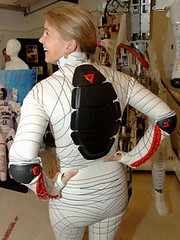Slim and Sleek in Your New Spacesuit
 Back in March, we wrote about the efforts of scientists to build the next generation of spacesuits, and their goal of halving the 300-lb weight of current spacesuits and increasing mobility.
Back in March, we wrote about the efforts of scientists to build the next generation of spacesuits, and their goal of halving the 300-lb weight of current spacesuits and increasing mobility.
Now, however, Dava Newman, a professor of aeronautics and astronautics and engineering systems at MIT, has a new "Biosuit" design that not only meets those requirements — but adds the all-important element of style.
MIT News explains:
Newman is working on a sleek, advanced suit designed to allow superior mobility when humans eventually reach Mars or return to the moon. Her spandex and nylon BioSuit is not your grandfather’s spacesuit–think more Spiderman, less John Glenn….
Newman’s prototype suit is a revolutionary departure from the traditional model. Instead of using gas pressurization, which exerts a force on the astronaut’s body to protect it from the vacuum of space, the suit relies on mechanical counter-pressure, which involves wrapping tight layers of material around the body. The trick is to make a suit that is skintight but stretches with the body, allowing freedom of movement.
Over the past 40 years, spacesuits have gotten progressively heavier, and they now weigh in at about 300 pounds. That bulk — much of which is due to multiple layers and the life support system coupled with the gas-pressurization — severely constrains astronauts’ movements. About 70 to 80 percent of the energy they exert while wearing the suit goes towards simply working against the suit to bend it.
Working in a three hundred pound suit is only possible in a low-gravity  environment. But if humans ever step foot on Mars, they’ll need lighter suits such as the one designed by Newman:
environment. But if humans ever step foot on Mars, they’ll need lighter suits such as the one designed by Newman:
Key to their design is the pattern of lines on the suit, which correspond to lines of non-extension (lines on the skin that don’t extend when you move your leg). Those lines provide a stiff "skeleton" of structural support, while providing maximal mobility….
The suits could also help astronauts stay fit during the six-month journey to Mars. Studies have shown that astronauts lose up to 40 percent of their muscle strength in space, but the new outfits could be designed to offer varying resistance levels, allowing the astronauts to exercise against the suits during a long flight to Mars.
Perhaps most amazing is the Biosuit’s safety aspect:
[I]f a traditional spacesuit is punctured by a tiny meteorite or other object, the astronaut must return to the space station or home base immediately, before life-threatening decompression occurs. With the BioSuit, a small, isolated puncture can be wrapped much like a bandage, and the rest of the suit will be unaffected.
To get a full perspective of the complex requirements that must be met for a spacesuit to function safely in the hostile environment of space, check out this entry from Wikipedia.